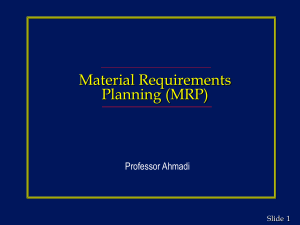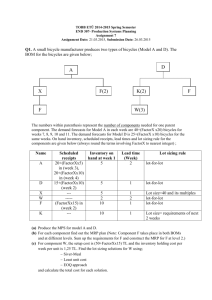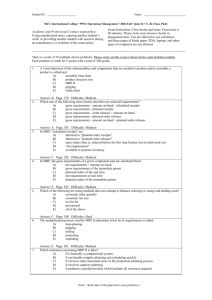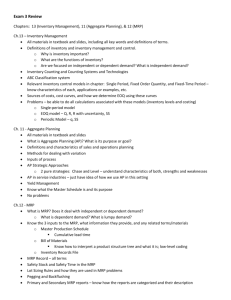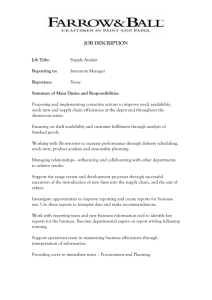MATERIAL REQUIREMENTS PLANNING
advertisement
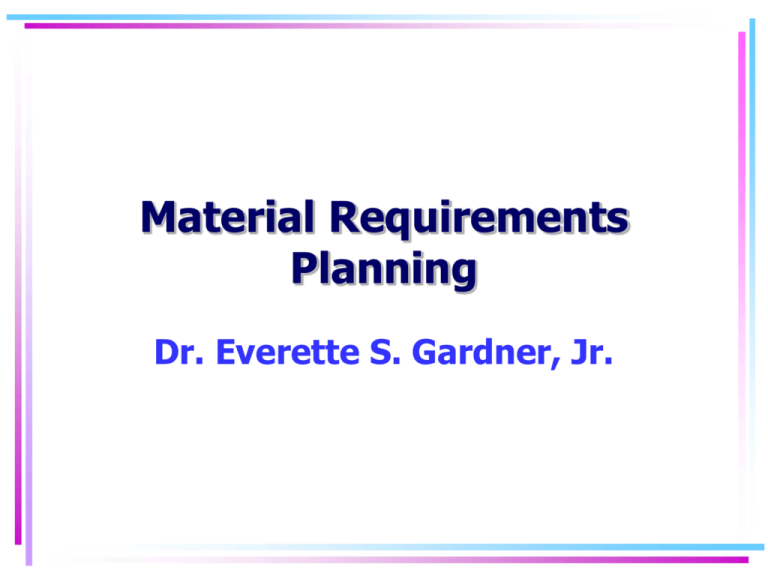
Material Requirements Planning Dr. Everette S. Gardner, Jr. End item R LT Time Component LT R Raw material LT Time R LT Time Order point system with dependent demand MRP 2 End item R Component Time Raw material Time Time The MRP approach MRP 3 The simultaneous probability problem • When components are ordered independently with an order point system, the probability that all will be in stock at the same time is much lower than the probabilities for individual components • Computation: Let Pn = Prob. that n components are in stock simultaneously Si = Prob. of stockout on one order cycle for component i Then Pn = S1 x S2 x S3 … Sn MRP 4 The simultaneous probability problem (cont.) • Example: End Item 1 2 3 S1 = .9 S2 = .9 S3 = .9 P3 = .9 x .9 x .9 = .729 = Prob. that all 3 components will be available at any given time to build the end item MRP 5 Probabilities of simultaneous availability of components Number of component items 1 2 3 4 5 6 7 8 9 10 15 20 25 Service level 90% 95% .900 .950 .810 .902 .729 .857 .656 .814 .590 .774 .531 .735 .478 .698 .430 .663 .387 .630 .348 .599 .206 .463 .121 .358 .071 .277 MRP 6 Demand forecasts and customer orders Aggregate planning/ master scheduling Product design changes Bill of materials MRP system Mfg. orders Inventory records Capacity report Purchase orders Detailed scheduling system Inventory transactions Performance/ exceptions Purchasing dept. MRP inputs and outputs MRP 7 Product tree vs. indented parts list • Product tree A B(2) D(1) E(3) D(2) Level 0 C(4) Level 1 F(1) G(3) Level 2 MRP 8 Product tree vs. indented parts list (cont.) • Indented parts list ● A ● B(2) ● D(1) ● E(3) ● C(4) ● D(2) ● F(1) ● G(3) MRP 9 Week 1 2 3 4 5 6 7 8 9 Lead time A Gross Rqmts. Planned order rls. 1 B Gross Rqmts. Planned order rls. 2 C Gross Rqmts. Planned order rls. 3 D Gross Rqmts. Planned order rls. 3 E Gross Rqmts. Planned order rls. 2 F Gross Rqmts. Planned order rls. 3 G Gross Rqmts. Planned order rls. 4 Quiz: MRP plan to produce 10 units of A — due in week 9 MRP 10 Problems in requirements computations • Product structure • Recurring requirements within the planning horizon • Multilevel items • Rescheduling open orders MRP 11 Product structure • Bills of material are hierarchical with distinct levels • To compute requirements, always proceed down bill of materials, processing all requirements at one level before starting another MRP 12 Product structure (cont.) • Example: Truck Level 0 Inventory O.H. 0 A. Transmission (1) 1 2 B. Gearbox (1) 2 15 C. Gear (1) 3 7 D. Forging Blank (1) 4 46 Suppose we are to produce 100 trucks. What are the net requirements for each component? MRP 13 Recurrence of requirements within the planning horizon • The same item may be required for several different lots within the planning horizon – always process one lot entirely, level by level, before starting the next. • Example: One lot of 12 trucks, followed by 2nd lot of 100 Lot 1 Lot 2 Level 1: Gross requirements 12 100 MRP 14 Multilevel items The same item may appear at different levels on one or more BOMs – result is multiple retrievals of same record to update system. Examples: 1 2 3 X Z Y A A A 4 A MRP 15 Multilevel items (cont.) Solution: Low-level coding. Lowest level an item appears is coded on inv. record. Processing delayed until that level reached. 1 X Z Y 2 3 4 A A MRP A A 16 Rescheduling open orders • Tests for open order misalignment: 1. Are open orders scheduled for periods following the period in which a net requirement appears? 2. Is an open order scheduled for a period in which gross requirement ≤ inv. O. H. at end of preceding period? 3. Is lead-time sufficient? MRP 17 Rescheduling open orders (cont.) • Example: 1 Gross requirements 30 Scheduled receipts On hand ● 27 -3 Week 3 4 5 6 5 10 10 10 20 20 12 2 2 12 12 22 Most MRP systems make such schedule changes automatically. MRP 18 Tactical questions in MRP • Regeneration vs. net change • Lot sizing • Safety stocks MRP 19 Regeneration vs. net change • Regeneration • Complete replanning of requirements and update of inventory status for all items • High data processing efficiency • Usually initiated by weekly update of master schedule • Net change • Daily update based on inventory transactions • More responsive to changing conditions • Requires more discipline in file maintenance MRP 20 Lot sizing implications in MRP • The load profiles at work centers in the system depend on the lot sizing rules used • Load profiles determine: undertime / overtime leadtimes • Example: Lot size Lot size Pd. Demand Rule 1 Rule 2 1 5 5 20 2 15 15 0 3 15 15 20 4 5 5 0 (Assume 1 unit requires 1 machine hour.) MRP 21 Machine hrs. Lot sizing implications in MRP (cont.) 20 20 15 15 10 10 5 5 0 1 2 3 0 4 Load profile – Rule 1 1 2 3 4 Load profile – Rule 2 MRP 22 Lot sizing techniques used in MRP systems • Lot-for-lot (L4L) – most used • Economic order quantity (EOQ) • Period order quantity (POQ) MRP 23 Lot-for-lot (L4L) example Period 1 2 Net rqmts. 35 10 Planned order 35 10 3 4 5 6 7 8 9 Total 40 20 5 10 30 150 40 20 5 10 30 150 (Assume Ø LT) The L4L technique: Minimizes carrying costs Is certainly the best method for - highly discontinuous demand - expensive purchased items MRP MRP1.xls 24 EOQ example Setup cost, S = $100 Unit price, C = $50 Holding costs, HR = .24 per annum HP = .02 per period Annual demand, D = 200 Q = (2DS / CHR)1/2 = 58 Period 1 2 Net rqmts. 35 10 Planned orders 58 Remnants 23 3 4 5 40 6 7 8 9 20 5 10 30 58 13 13 MRP 31 10 58 31 11 6 54 24 24 25 Period order quantity example Technique: 1. Compute EOQ to determine number of orders per year 2. Divide number of periods in one year by number of orders to get ordering interval EOQ = 58 Number of periods in one year = 12 D = 200 200 / 58 = 3.4 (orders per year) 12 / 3.4 = 3.5 (ordering interval) Period 1 2 Net rqmts. 35 10 Planned orders 85 3 4 40 5 6 7 8 9 Total 20 5 10 30 150 35 MRP 30 26 Safety stocks in MRP systems • Need for safety stocks: • Variations in demand due to end-item forecast errors and inventory errors • Variations in supply – both lead-times and quantities • Since demand is not random, traditional statistical techniques do not apply. • Options to provide safety factors: • Fixed quantity buffer stocks • Safety lead-time • Increase gross requirements MRP 27 Safety stocks in MRP systems (cont.) • Fixed quantity buffer stocks • Good rule of thumb: Set buffer = max. demand likely in a single period • Never generate order solely to replenish buffer stocks • Safety time method • • • • Simply order early Distorts LTs and priorities Better than buffer stocks for items with infrequent demand Also better for purchases outside company • Increase in gross requirements • Should be done at end item level only so that » Components available in matched sets » Safety stocks are not duplicated at different levels MRP 28

